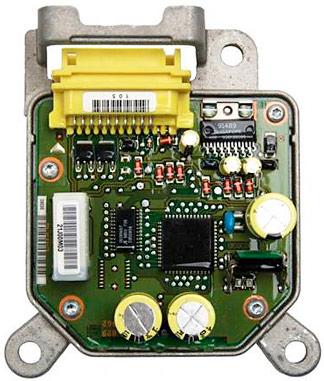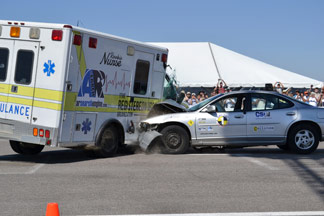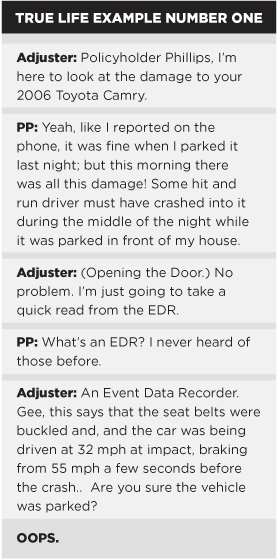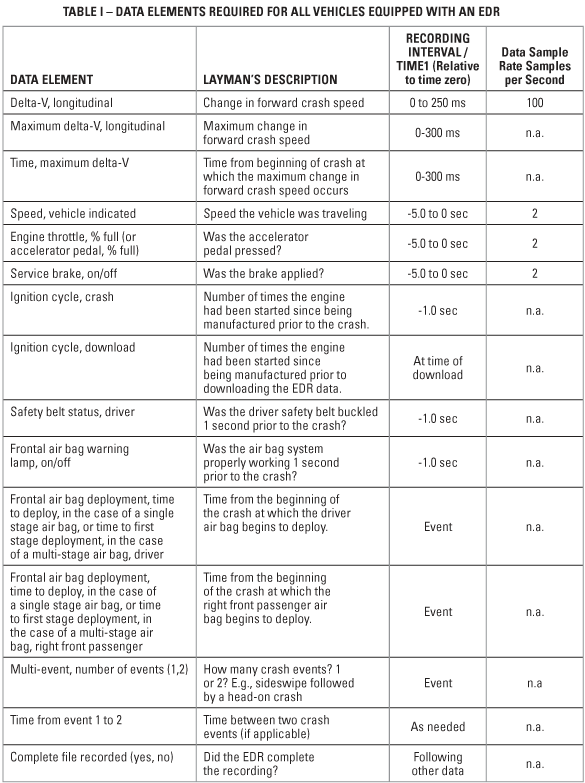Fraud fighters are constantly looking for new approaches to oldproblems while sometimes applying old approaches to newones.
|Within the realm of auto claims, p&cinsurers devise strategies that meld biomechanicalengineering with investigative acumen and thelatest technologies.
|Although event data recorders (EDRs)—also referred to as “littleblack boxes”—have been around for years, insurers are findingnew ways to better utilize the data they collect in order to make moreaccurate liability determinations. To this end, asister industry has emerged to offer various products toenhance the value of EDRs. Some of these products mayultimately impact auto claims handling in a meaningfulway.
|The Crash Data Retrieval (CDR) tool, for example, is onesuch product that is assisting insurers in accident investigationstoday. The CDR tool uses a combination of hardware andsoftware to read crash data found in a vehicle's EDR.
| Anatomy of an EDR
Anatomy of an EDR
Sensors located throughout the vehicle feed information back tothe “brains” or electronic control units(ECUs), contained within thevehicles Air Bag Control Module (ACM),which is typically foundin a fairly well-protected area—for example, under the driver'sseat, the center console, or in another protectedlocation.
|If a car hits a tree, the standard EDR data will reflect theexact speed of the car upon impact; the acceleration ordeceleration for a number of seconds before and just after impact;show whether the foot was on the brake or still on the gas; andoffer many other items of fact. Now imagine a precise, multi-secondlooping device that records and saves data at each and everytriggering incident.
|Using this real-world data, the government can develop moreeffective occupant protections and motor vehicle safety programs,while manufacturers can collect information with which toimprove vehicle safety in a crash event, thereby enhancing safetyin future generations of vehicles. Collected data can providevaluable information on the severity of the crash, operation of theair bag, and what deployment decision strategies were used duringthe event.
| Some of the collected data points include any change inforward crash speed; the maximum change in forward crash speed; thetime from the beginning of the crash at which the maximum change inforward crash speed occurs; whether the gas pedal was pressed andwhether the brake was applied, whether the driver's seat belt wasbuckled before the crash; whether the air bag worked correctly; andso on.
Some of the collected data points include any change inforward crash speed; the maximum change in forward crash speed; thetime from the beginning of the crash at which the maximum change inforward crash speed occurs; whether the gas pedal was pressed andwhether the brake was applied, whether the driver's seat belt wasbuckled before the crash; whether the air bag worked correctly; andso on.
Under specific conditions, the EDR will also record thefollowing information: sidewaysacceleration or force; forward or rearward acceleration or force;vertical acceleration or force; engine RPMs; whether the vehiclerolled over; steering wheel operation five seconds before thecrash; and a host of other items listed in the table on the lastpage of this article.
|| There is nothing new about EDRs. Theautomobile manufacturing industry initially developed them becauseit needed not only to make a safer automobile, but to defend itselfin cases of “he said/she said” litigation. The initial EDRtechnology caught the public eye during the years of phantomacceleration claims against Toyota and has progressed since thattime.
There is nothing new about EDRs. Theautomobile manufacturing industry initially developed them becauseit needed not only to make a safer automobile, but to defend itselfin cases of “he said/she said” litigation. The initial EDRtechnology caught the public eye during the years of phantomacceleration claims against Toyota and has progressed since thattime.
Seconds of Data…
|With the technology exactly as it is, an EDR readout willprovide technical vehicle and occupant information for a shortamount of time just prior to an event, during an event, and for abrief period after an event. We are talking about seconds, notminutes, of data capture. It's enough data to provide a claimsadjuster or fraud investigator with a fairly good portrayal of whatactually happened.
|Witnesses can be less reliable, as there often are conflictingperceptions and accounts of a given incident. EDRtechnology, on the other hand, provides indisputable evidence. Evenso, raw data is just that…raw data.
|The EDR may record pre-crash vehicle dynamics and system status,driver inputs, restraint usage/deployment status, and post-crashdata, such as activation of an automatic collision notificationsystem. While this may draw initial comparisons to an airplane'sinfamous black box, there are some key differences. The black boxon a plane records details about the flight for the entire durationof the trip. An EDR System, on the other hand, records mereseconds of information. Furthermore, the airplane's black boxrecords sound, whereas the EDR unit does not.
|Rather, EDR readouts supply technological details via numbersand measurements. As far as we know, none of them includea voice clip to the effect of ”Honey, slow down before you hitthat…” followed by a loud noise.
|Experts estimate that approximately 64 percent ofvehicles had EDR capability during the year 2005. Each year, thatpercentage has increased. The data is there to be not only accessedbut also applied in claims. As we establishedearlier, various commercially available tools are ableto read and report EDR data. But what is involved inimplementing such tools into the claims adjusting realm?
|Navigating Trial Programs
|At least three major insurers are currently conductingtrials with EDR readers to ascertain potential cost savings.So far, the feedback has been promising. The considerations of atrial program include:
|Standardization. While the majority of vehiclesnow on our highways have EDRs, there was never any absolutestandardization between EDR reporting methods. EDR data isproprietary to each auto manufacturer. Ford has its version;Toyota has another version; and Honda, still another. So what isdifferent now? The National HighwayTransportation Safety Administration (NHTSA) has issued aregulation to standardize the data collected and recorded by anEDR. Beginning with the model year 2013, NHTSA defined the minimumdata set (15 items) that must be collected if a manufacturerdecides to voluntarily install an EDR in its vehicle lines, alongwith requirements for the range of accuracy of EDR data.
|Additionally, as of 2014, it is proposed any new car sold in theUnited States must be equipped with an EDR. This also applies toforeign manufacturers; if you sell the vehicle in the unitedStates, it must have an onboard EDR. Period. Since the designs areproprietary, many manufacturers have significantly added to thoseminimum data points defined by NHTSA. Items of measurement arecontinually being added to the units, limited only by cost andimagination.
|Cost of Equipment. If Gigantic InsuranceCompany (GIC) has ten regional claims processing centers, thetrial program shopping cart would look like this. Two regions(Atlanta serving the eastern U.S. and Los Angelesserving the western U.S.) would each own one top-of-the-linePremium EDR Tool (approximately $10,000 each). Satellite claimspersonnel; 24 on each side of the country, 48 in total wouldeach get a basic EDR tool, currently priced just under, let's say,$3,000 each. (Both commercially available units can take theEDR data snapshots. Premium kits contain additional cables to takethe EDR data snapshots from more seriously damagedvehicles.)
|Now add in the cost of training and the cost todeliver that training to those so designated, and GIC is up andrunning (hypothetically speaking) for less than $190,000. EDR toolhardware is purchased one time with an annual software renewalrequired to keep up with manufacturer changes and data reportingabilities. Considering the above scenario and the cost oftoday's claims, the ROI of implementing an EDR tool could beimpressive.
|Application. GIC's 50 units would be inconstant use. Capturing the data is not rocket science. The readoutis, in effect, just one more witness statement, untarnished by theability to remember or interprete accurately, or any otherhuman variable.
|Recognition of Value. The old adage, “a pictureis worth a thousand words” has lost much of its luster with themarch of technology, at least a visual image. To be clear, in thecase of EDR there are no actual pictures. An EDR report is anobjective printout of the crash data—or perhaps the lackof data if there was no measurable impact—and has withstood legalchallenges because it rises above speculation. Courts can subpoenaEDR data, and some states collect data under existing lawsgoverning crash investigations. Moreover, insurance policies mighthave contract terms related to data collection from EDRs. It bearsmention that nearly 100 court cases have used EDR data in theproceedings, showing a willingness to allow EDR data entered asevidence.
|Right to Accessibility. So who owns theinformation collected by an EDR? Can the government, insuranceinvestigators or police just waltz in and download the data?Ownership of the EDR and its data is a matter of state law, andsuch provisions vary considerably. NHTSA considers the owner of thevehicle to be the owner of the data collected from an EDR. Theowner can give permission to download EDR data or courts cansubpoena EDR data. Big city police agencies or Highway Patrol unitsthat use the EDR tool collect data under their existing state lawsgoverning crash investigations. For crash investigations conductedby NHTSA, the agency obtains permission from the vehicle ownerbefore downloading the EDR data. Up-to-date policy languageincludes contract terms related to data collection from EDRs.
|The Adventures of Rusty Haight
|Once a year, late in the spring, the Las Vegas Speedway comes tolife in a whole different way. An estimated 200 accidentreconstruction specialists arrive to witness the latest antics(insanity being far too harsh of a word) of Rusty Haight, bestdescribed as the human crash dummy. Rusty, at last count, waswithin near striking distance (no pun intended) of hitting (again)the 1,000 crash mark. Those who know him well were said to beplacing sideline wagers on what crash #1000 would looklike.
|Crashes are staged using a series of donated automobiles,trucks, and (this year) even a bus. They have been outfittedwith cameras on the inside—to enable a slow motion viewof the body's movement upon impact. These cameras have placedat strategic outside locations to show, again in slow motion, thesometimes spectacular crumbling of the vehicles. Seeing isbelieving. A car traveling at 15 miles per hour (mph), straightinto a concrete barrier, has near violent results for the properlybelted driver. Any variation in vector can change the expectedpattern of injury. Two cars, each traveling head-on at 15 mph, havethe combined velocity of about a 30-mphcrash; injuries increaseaccordingly.
|During most staged crashes, Rusty wears a chest plate, whichserves to spread the force exerted on his body from the seat belt.In the 15-mph crash, he left the plate behind—and while he sufferedmightily, the pictures were all telling. In slow motion, two thingswere very evident. First, instead of the anticipated back/forthflexion extension, Rusty went up off of his seat and then rolledover the seat belt in a left torque. Exploring theexpected biomechanical stressors versus theactual biomechanical stressors is fodder for anotherentire article. Suffice it to say, even the old pros, includingRusty, learned a thing or two.
|EDRs trace their roots to the installation of air bags invehicles. For air bags to operate properly in the event of a crash,automobile manufacturers developed control units to detect when acrash occurs and deploy the air bag if needed. Even the earliestEDR technology involved “thinking” units, albeit in a somewhatprimeval form. (Input: big impact. Result: deploy airbags!) . Asthe air bag control units became more sophisticated, automobiledesigners realized data collected from the control units could beused to further improve air bag design. To collect these datapoints, designers increased the functionally of the air bag controlunit to permit storage of the data after a crash so it could bedownloaded and analyzed later. They also learned to store eventsthat were significant enough to register, but not significantenough to deploy the airbag.
|Automatic collision notification (ACN) systems and EDRs areseparate functions. ACN is a system that can automatically notify athird party (such as a 911 operator or a call center) when a car isinvolved in a collision. Some cars and light trucks have ACNdevices, such as GM's On- Star™ system. Some of these systems usedata from the EDR to determine crash severity, thereby helping toensure an appropriate level of medical response. Technology allowsthe ambulance to be summoned even if the driver is upside down in aditch and unconscious.
|Who Owns the Information?
|Ownership of the EDR and EDR data is a matter of state law, andsuch provisions vary considerably. The owner can give permission todownload EDR data. In addition, courts can subpoena EDR datathrough court orders, and some states collect data under theirexisting state laws governing crash investigations. For crashinvestigations conducted by NHTSA, the agency obtains permissionfrom the vehicle owner before downloading the EDR data. Recentlydrafted insurance policy wording may have contract terms related todata collection from EDRs.
|Some vehicle manufacturers have licensed a third party todevelop the downloading process tools that permit owners ofvehicles to download data from an EDR. Contact the manufacturer ofthe vehicle for information on tools to download EDR data.
|Emerging Applications
|While EDR reports have been widely used by law enforcement andthe accident reconstruction communities, there is currently a pushto involve EDR reporting in the used car and fleet managementindustries to help improve the transparency of the vehicle beingoffered for sale and close the gap in vehicle historyreporting. A typical scenario would be to get the EDR datafrom a vehicle being brought in for a trade-in or lease return toget a true representation of the vehicles condition. An EDRreport will may help analyze the vehicle safety systems along withverification that there are no unreported stored events that maydegrade the vehicles safety systems or the vehicle itself.
|
Want to continue reading?
Become a Free PropertyCasualty360 Digital Reader
Your access to unlimited PropertyCasualty360 content isn’t changing.
Once you are an ALM digital member, you’ll receive:
- All PropertyCasualty360.com news coverage, best practices, and in-depth analysis.
- Educational webcasts, resources from industry leaders, and informative newsletters.
- Other award-winning websites including BenefitsPRO.com and ThinkAdvisor.com.
Already have an account? Sign In
© 2024 ALM Global, LLC, All Rights Reserved. Request academic re-use from www.copyright.com. All other uses, submit a request to [email protected]. For more information visit Asset & Logo Licensing.








